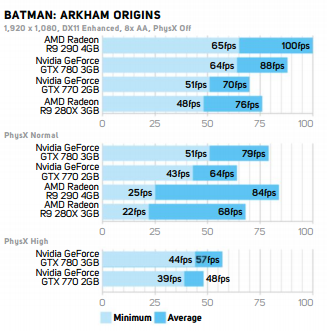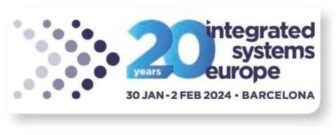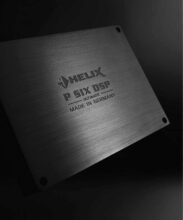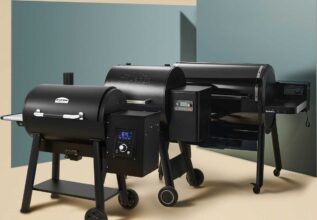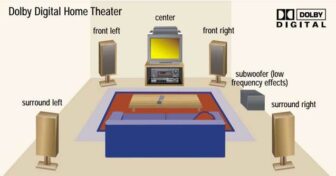NVIDIA PHYSX
What benefits does hardware accelerated physics processing bring to Batman?
In order to cut through the marketing jargon, we’ve based our scores on a bang per buck scale. However, both AMD and Nvidia offer unique additional features. Recently, for example, AMD has been promoting its Mantle API and TrueAudio, while Nvidia is marketing G-Sync and PhysX.
Here, we’re going to look at the latter to assess the difference it can make to your gaming experience.
WHAT IS PHYSX?
PhysX is essentially a physics simulation engine. It was originally designed to run on dedicated PPU cards, or via software, but since Nvidia’s acquisition of its original maker, Ageia, dedicated PPUs have been abandoned. Although the engine itself can run on various systems through software, including consoles and AMD cards, it’s optimised to run best on GeForce graphics cards that are CUDA-enabled.
PHYSX TESTING
Batman: Arkham Origins is the latest game to feature Nvidia-exclusive PhysX features. For testing, we’ve compared the GTX 770 with the R9 280X, and the GTX 780 with the R9 290, as our original game tests showed these cards to be closely matched. We also ran the entire built-in benchmark, rather than our usual 60-second snippet, so that we could fully capture the various physics simulations. 
The in-game PhysX settings are Off, Normal and High. Normal graces the game with interactive paper, debris and banners.
For example, running through or near some debris, or running through some hanging toilet paper, will cause it to move realistically based on your movements. This setting is available when using an AMD card, but the CPU will handle the calculations. High is reserved for Nvidia users, and adds extra effects for steam, smoke and snow. On Normal, the additional debris is easy to spot, and adds a decent touch of realism, but the performance impact can be big. The GTX 780’s minimum frame rate falls from 64fps to 51fps at 1,920 x 1,080, a 20 per cent decrease, while the GTX 770 suffers a similar 16 per cent drop, although both results are still playable.
The impact on AMD hardware, however, is drastic. Although the average frame rates are higher than those of their Nvidia counterparts, even the R9 290 only manages a minimum result of 25fps at 1,920 x 1,080 – this is only just on the borderline of being playable, which is shocking for a card only running at 1080p. The PhysX intensive portions are very CPU-limited, and even our overclocked Core i7-3570K doesn’t have enough power to maintain satisfying frame rates at these settings. Visually, the High PhysX setting is where you see the biggest difference. Fog and smoke are more prevalent and are clearly simulated, rather than just being animated. Meanwhile, the additional particle effects and tessellation in the snow, both in the air and on the ground, are also pleasing to watch. This improved experience costs the GTX 780 another 16 per cent in lost frames (31 per cent in total compared to no PhysX), while the GTX 770 loses just 9 per cent (24 per cent in total). Both cards also maintain frame rates well above 30fps at this setting.
CONCLUSION
If you particularly love a game that supports PhysX (The Witcher 3 will support it, for example), then it’s definitely worth considering buying Nvidia hardware to get the ultimate level of realism. However, it’s only supported in eight 2013 games, and that’s always the crux with such middleware packages, including AMD’s Mantle and TrueAudio. 